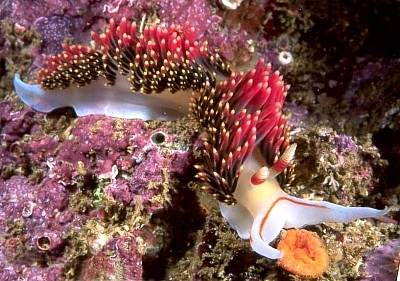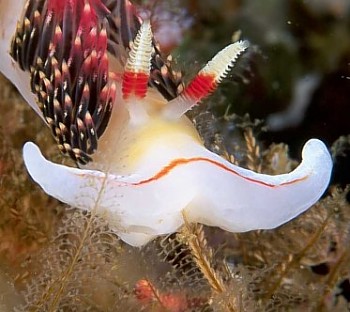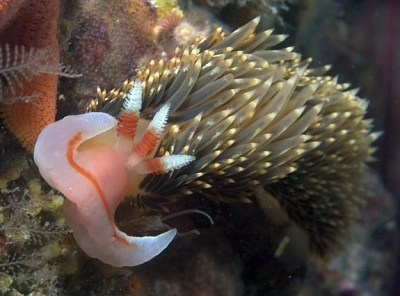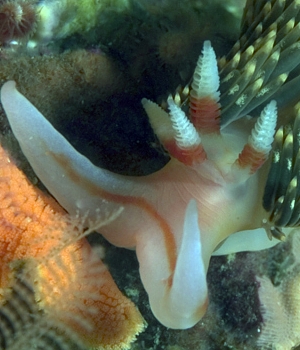

Phidiana hiltoni
O'Donoghue, 1927
Order: NUDIBRANCHIA
Suborder: AEOLIDINA
Family: Glaucidae
DISTRIBUTION
Central coast of California to Baja California, Mexico, Gulf of Mexico.
PHOTO
Bruce Wight.
Grows to 50mm. Feeds on hydroids, including Hydractinia, and attacks other aeolids.
The original description was based on a preserved specimen, the colour notes of the living animal stating merely that the body colour was 'light' and the cerata "dark". MacDonald, 1983 felt there was enough anatomical information in this original description to identify O'Donoghue's species with the later, but much more appropriate, name Phidiana pugnax Lance, 1962.
This species has a reputation for pugnaceous behaviour, [hence the name pugnax] biting and fighting with other aeolids, including others of its own kind. See Bruce Wights' photos below.
-
McDonald, G. R. (1983) A review of the nudibranchs of the California coast. Malacologia, 24(1-2): 114-276.
-
O'Donoghue, C. H. (1927) Notes on a collection of nudibranchs from Laguna Beach, California. Journal of Entomology & Zoology, Pomona College, 19(1-4): 77-119, pls. 1-3.
Rudman, W.B., 2000 (July 15) Phidiana hiltoni O'Donoghue, 1927. [In] Sea Slug Forum. Australian Museum, Sydney. Available from http://www.seaslugforum.net/find/phidhilt
Related messages
Re: Phidiana hiltoni with 4 rhinophores
June 30, 2006
From: Blair Carmichael

Concerning message #16396:
Dr Bill,
I have now seen a few more of these guys with some strange things going on.
I'm not sure if it's getting more common, or I might be just a little more observant.
Locality: Santa Cruz Island, 40 Feet, California USA, Pacific, 6-24-2006. Length: 50+ mm. Photographer: Blair Carmichael
These are also larger slugs so any abnormalities are easier to see. Both of them are from Santa Cruz Island.
Thanks,
Blair
Blaircarmichael@yahoo.com
Carmichael, B., 2006 (Jun 30) Re: Phidiana hiltoni with 4 rhinophores. [Message in] Sea Slug Forum. Australian Museum, Sydney. Available from http://www.seaslugforum.net/find/17023
Dear Blair,
I can't really say if you are looking harder than everyone else, or if there are an abnormally large number of mishapen P. hiltoni in your area. I guess we would need to know how many 'normal' ones you see as well.
The rhinophore situation in the photo alongside is almost certainly the result of recent damage. This species is well known as a 'fighter' attacking and biting other nudibranchs and others of its own species as well. I suspect this is an aeolids equivalent of a boxer's mishapen nose, from one punch too many. However the bifid oral tenatcle in the upper photo seems to be developmental, as did the bifid rhinophores in your earlier message.
Best wishes,
Bill Rudman
Pale form of Phidiana hiltoni
May 10, 2006
From: Elijah Woolery

Hello-
I found a couple of these specimens in the intertidal, just wondering if they are Hermissenda crassicornis (if so, I've never seen this color morph). Thanks for your help!
Locality: Fitzgerald Marine Reserve, 1 m, California, USA. 24 April 2005. rocky intertidal Length: 20 mm? Photographer: Elijah Woolery.
Elijah Woolery
www.outofthedeepblue.com
eli@outofthedeepblue.com
Woolery, E.W., 2006 (May 10) Pale form of Phidiana hiltoni. [Message in] Sea Slug Forum. Australian Museum, Sydney. Available from http://www.seaslugforum.net/find/16474
Hi Eli,
Thanks for the interesting shots. Your species is actually Phidiana hiltoni. Normally Phidiana has a red line across the front of the head making it extremely easy to identifiy. Your specimens are very light colored, kind of faded, and therefore for some reason lack this line.
Note however, they do have the characteristic red band on the lower portion of the rhinophores, and white on the upper half. Also, the cerata have dark core with yellow tips.
Hermissenda on the other hand always has the distinctive yellow-gold line down the center of the dorsum, flanked by blue. Also, the rhinophores in Hermissenda have a few irregular rounded rings or annulae, while in P. hiltoni the rhinophores are perfoliate [having many thin closely packed lamellae].
We always enjoy seeing extreme cases of color. Keep up the good work.
Thanks again,
Dave Behrens
Phidiana hiltoni with 4 rhinophores
April 21, 2006
From: Blair Carmichael

Dr. Bill,
Here is another one for your abnormalities list.
Phidiana hiltoni with 4 rhinophores.
Locality: Santa Cruz Island, 40 Feet, California USA, Pacific Ocean, 17 April 2006, West end of the Island. Length: 50+ MM. Photographer: Blair Carmichael.
Thanks,
Blair
Blaircarmichael@yahoo.com


Thanks Blair,
Bill Rudman
A sea slug? from California
March 3, 2006
From: Mila Zinkova

Dear, Bill,
I took the pictures in California (tidepools)
Is this a sea slug? (orange one) I do not recall I've ever seen a sea slug that has small particales of sand and shells on its body like this one does.
The third picture is a different sea slug. It seemed to me that it was afraid of a hermit crab. What is this sea slug and was it really afraid of a hermit crab?
Locality: Half Moon Bay, tide pools, California, US, Pacific, 24 February 2006, Low tide zone. Length: .5 inches. Photographer: Mila Zinkova.
Thank you.
Mila.
georgekaskanlian@comcast.COM


Dear Mila,
Thanks for sending us these photos. First the orange critter is often confused with dorid nudibranchs, but is not even a mollusc. This animal is the creeping sea cucumber, Psolidium bidiscum. Its gill looks identical to the dorsally situated gill of a dorid nudibranch.
Your other photos are of the aeolid, Phidiana hiltoni. It was previously named Phidiana pugnax, to draw attention to its pugnacious behavior I am sure that is what is being demonstated here as I suspect your specimen is attempting to scare off the potentional hermit crab predator.
Best wishes,
Dave Behrens
Phidiana hiltoni north of Monterey, CA
August 24, 2005
From: Ken-ichi Ueda

This may be sort of nit-picky, but your species account for Phidiana hiltoni lists its range as extending only as far north as Monterey Bay, while Behrens' 2004 supplement to Pacific Coast Nudibranchs lists the northern-most extent as Duxbury Reef in Bolinas, CA, which is a bit north of San Francisco. Just thought I'd report that P. hiltoni is alive and well at Duxbury, where I observed several large (~4 cm) adults on 8.20 August 2005.
Locality: Duxbury Reef, Bolinas, California, USA. Length: ~4 cm. 20 August 2005. Rocky intertidal. Photographer: Ken-ichi Ueda
Ken-ichi Ueda
kenichi.ueda@gmail.com
Ueda, K.M., 2005 (Aug 24) Phidiana hiltoni north of Monterey, CA. [Message in] Sea Slug Forum. Australian Museum, Sydney. Available from http://www.seaslugforum.net/find/14623Dear Ken-ichi,
I guess it is a bit nit-picky, but you're allowed to be. I am never sure whether to be general or more detailed with distributions, as animal distribution records often tell us as much about the distribution of biologists as they do about the geographical range of a species. Perhaps I should just say central California?
Best wishes,
Bill Rudman
Phidiana hiltoni from the Channel Islands, California
August 9, 2005
From: Bruce Wight

Dear Bill,
Here's another nudibranch from my first dive trip since November. Thios photo of Phidiana hiltoni was taken during a three day Channel Islands trip [California]. It was shot at Santa Barbara Island, not used to seeing them there mainly see them at San Miguel Island.
Take care,
Bruce Wight
bruce.c.wight@boeing.com
Wight, B.C., 2005 (Aug 9) Phidiana hiltoni from the Channel Islands, California. [Message in] Sea Slug Forum. Australian Museum, Sydney. Available from http://www.seaslugforum.net/find/14508
Thanks Bruce,
I've include a close-up because it shows the rhinopore shape of this species very clearly
Best wishes,
Bill Rudman
Phidiana hiltoni from California
September 30, 2001
From: Bruce Wight

Hi guys,
Here is the gorgeous Phidiana hiltoni I mentioned in my earlier message. I photographed it on my 4 day trip out to Santa Barbara Island, California last week, in about 40 feet of water at 7 1/2 fathoms reef.
Take care,
Bruce Wight
bwproductions@earthlink.net
Wight, B., 2001 (Sep 30) Phidiana hiltoni from California. [Message in] Sea Slug Forum. Australian Museum, Sydney. Available from http://www.seaslugforum.net/find/5343Thanks Bruce,
Bill Rudman
Phidiana hiltoni feeding
July 15, 2000
From: Bruce Wight


Dear Bill,
I know you are interested in shots of the feeding behavior, so here is a close-up shot of a Phidiana hiltoni stripping the shaft of colonial hydroids bare.
I have also sent some photos of P. hiltoni fighting.
Take care,
Bruce Wight.
bwproductions@earthlink.net
Wight, B, 2000 (Jul 15) Phidiana hiltoni feeding. [Message in] Sea Slug Forum. Australian Museum, Sydney. Available from http://www.seaslugforum.net/find/2715Dear Bruce,
Thanks very much for these beautiful photos. It is good to see photos of animals feeding as it not only gives us clues on their diet but also on how they eat. There is quite a difference between small aeolids like Flabellina poenicia, which carefully bites off one polyp at a time, and P. hiltoni in your photo, devouring a whole stalk at once.
Best wishes,
Bill Rudman.
Phidiana hiltoni fighting
July 15, 2000
From: Bruce Wight


Dear Bill,
As I said in my earlier message, I have seen many Hermissenda crassicornis nudibranchs together and have never seen two acting aggressively towards each other.
There is one local aeolid however, that is very aggressive towards others of its own kind, and that is Phidiana hiltoni. If two are put together in the wild, they will immediately start to fight, tearing into and ripping cerata off each other. Here are two photos of the combat.
Take care,
Bruce Wight
bwproductions@earthlink.net
Wight, B., 2000 (Jul 15) Phidiana hiltoni fighting. [Message in] Sea Slug Forum. Australian Museum, Sydney. Available from http://www.seaslugforum.net/find/2716Dear Bruce,
Thanks again. I don't know about anyone else, but your photos of Phidiana hiltoni feeding and fighting, have brought a species I have never seen, to life for me.
Best wishes,
Bill Rudman.
